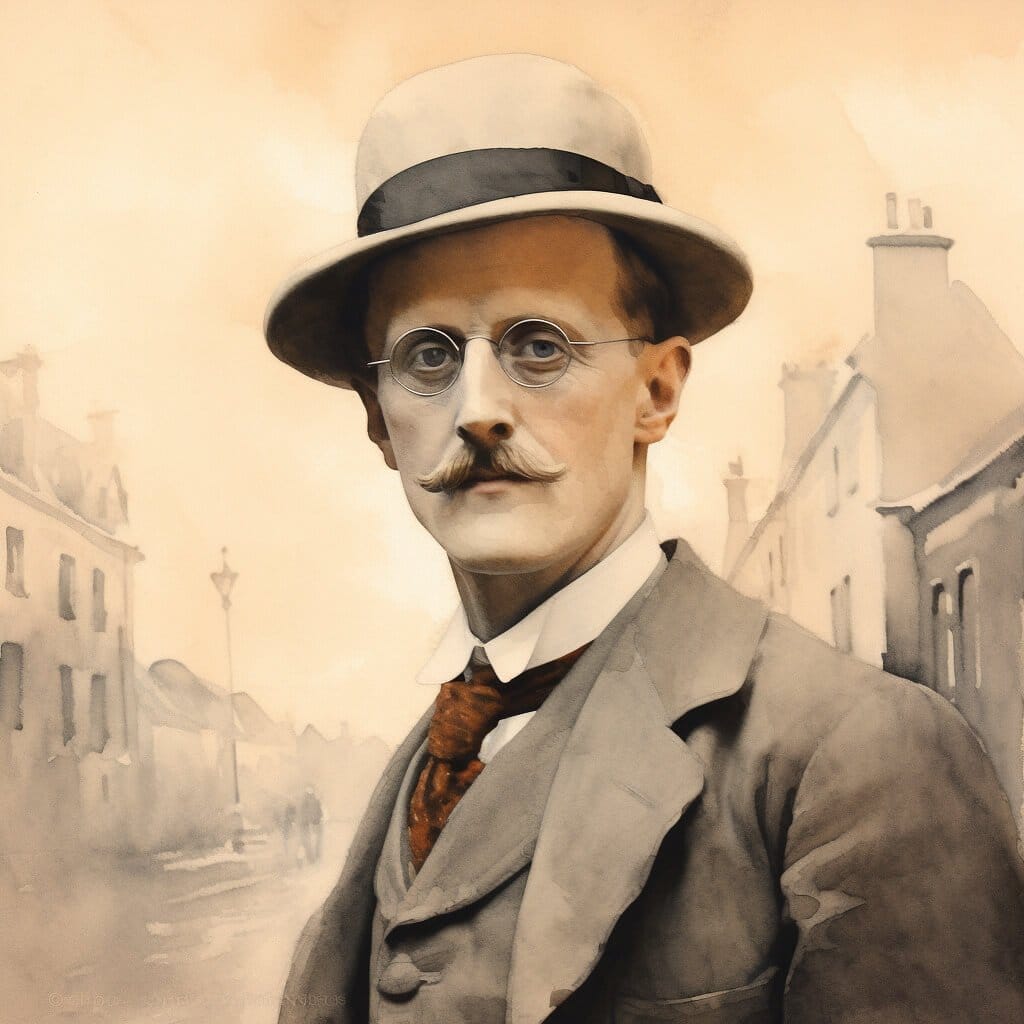Hailed as one of the most influential writers of the 20th century, Joyce was an Irish poet, prose writer, and novelist who was known for his experimental style that took the literary world by storm. His poems, novels, and short stories expressed a mastery of language whilst exploring the human condition. James Joyce’s literary legacy extends far beyond his own lifetime. He inspired many future writers that came after him, such as Seamus Heaney, Sylvia Plath, T.S. Eliot, Ezra Pound, and Elizabeth Bishop.
Early Life
James Joyce was born in Rathgar, a suburb of Dublin, Ireland February of 1882. He was the oldest of ten surviving children born to parents John Stanislaus Joyce and Mary Jane Murray. In 1887, Joyce’s father was made a rate collector for the Dublin Corporation. This change of employment instigated a move to the town of Bray, just outside of Dublin.
Education
The young boy’s education began at Clongowes Wood College in 1888. The institution was a Jesuit school. He was faced with leaving in 1892 when his father was no longer able to afford the tuition. It is known that one of Joyce’s earliest pieces was written in 1891 in reaction to the death of Charles Stewart Parnell. He studied at home for a time before enrolling in the Belvedere College. Three years later, he was studying English, French, and Italian at University College Dublin.
Joyce was very active in the art scene while at university. In 1900 a review he wrote was published in The Fortnightly Review. This was his first published work. He also wrote articles and two plays during this period. Those he befriended in school made their way, in many instances, into his later works. These included some of his closest associates, such as Oliver St. John Gogarty. He graduated in 1902 and went to Paris to study medicine. This professional choice did not last long, and he returned to England, claiming ill-health.
Soon after, his mother succumbed to cancer. Her death only increased the amount of time Joyce spent drinking. The poet managed to make a living for himself by publishing book reviews and taking on various teaching jobs. In 1904 Joyce tried for the first time to have A Portrait of the Artist published. It was later rewritten as A Portrait of an Artist as a Young Man. The following months were spent in Dublin, where he continued to drink. He met and began a relationship with Nora Barnacle. Later that year, in October, Joyce would find himself in Pola in Austria-Hungary with Nora, which is now modern-day Pula, Croatia, where he held a position at the Berlitz School. The two moved to Zurich, Switzerland, and then to Trieste, Italy, in the latter part of 1905.
Italy and Switzerland
While in Italy, Nora gave birth to the couple’s first child, George. Their residence in the city did not last long, and soon Joyce moved the family to Rome, where he found work as a bank clerk. Again, he was unhappy, returning to Trieste in 1907. It was around this time that his daughter Lucia was born. In 1909 Joyce returned to Dublin along with his son. It was his intention to visit his father and to have his collection of stories, Dubliners, published. This work was deeply inspired by Irish nationalism and the search for the Irish identity. Each story is centered around a certain character’s epiphany or sudden understanding. These usually revolved around something personal. The work was not published until 1914. It was during this time that Joyce published a number of stories under the pseudonym Stephen Dedalus. Under this name, he created The Sisters, Eveline, and After the Race.
In 1914 a number of his poetic works were included in the Imagist Anthology created by Ezra Pound and T.S. Eliot after the pair noticed the quality of James Joyce’s poetry. Pound described Joyce’s poem ‘Chamber Music‘ as having ‘quality and distinction.’
Financial Difficulties and Literary Successes
Upon returning to Trieste, Joyce wrote poetry, such as ‘Gas from a Burner.’ During these years, Joyce was still desperate to support his family. He spent time trying to work as a cinema magnate, planning to import Irish tweed to Italy, and borrowing money to keep his family from becoming homeless. The only income he was receiving came from the teaching position he maintained, along with his private lessons.
Joyce moved to Zürich at the start of the first world war. Here he became interested in socialism. It was his goal, after moving yet again to Paris, to finish his great novel, Ulysses. The work chronicles a day in the life of a Dublin inhabitant Leopold Bloom, turning an ordinary day in the city into a modern version of Homer’s Odyssey. The book was finally finished in October 1921 and published by Shakespeare and Company in 1922 by Sylvia Beach. It became widely considered a masterpiece by critics and scholars alike. Interestingly, due to the state of censorship in Great Britain and the United States, Joyce made the choice to publish Ulysses in France.
Luckily, this period also saw his reputation grow into that of an avant-garde writer. The good news came alongside the bad as his eyes began to deteriorate. He had a number of procedures throughout his life to try to correct them, often having to wear an eyepatch. The outbreak of World War II had a significant impact on the direction of Joyce’s life, as upon the Nazi occupation of France, Joyce moved to Zürich again.
Later Life and Death
Joyce was prolific well into the later part of his life. In 1939, Joyce published another one of his most renowned works Finnegans Wake. However, On January 13, 1941, after undergoing surgery for a perforated duodenal ulcer, Joyce fell into a coma. He woke once two days later to ask for his wife before dying fifteen minutes later. He was fifty-eight years old. After his funeral, he was buried in Fluntern Cemetery in Zürich.
Since his death, Joyce’s work has come to influence writers such as Samuel Beckett and John Updike. Ulysses is considered one of the major works of the Modernist movement. His life and work are celebrated every year on 16th June on Bloomsday.
Famous Poems
James Joyce was responsible for a number of iconic works. Here are some of his most famous poems:
- ‘Ecce Puer‘
- ‘She Weeps over Rahoon‘
- ‘Nightpiece‘
- ‘Alone‘
- ‘Flood‘
- ‘On the Beach at Fontana‘
- ‘Simples‘
- ‘Tutto Sciolto‘
- ‘A Prayer‘
- ‘The twilight turns from amethyst‘
- ‘At That Hour‘
- ‘Bahnhofstrasse‘
- ‘Be Not Sad‘
- ‘Dear Heart, Why Will You Use Me So?‘
- ‘Go Seek Her Out‘
- ‘He Who Hath Glory Lost‘
- ‘I Hear an Army‘
Influences
Like many of the great poets of our time, James Joyce’s style was somewhat impacted by his literary heroes and inspirations. Some of these included Henrik Ibsen, Homer, Dante, William Shakespeare, and Gustave Flaubert.
Joyce’s work continues to be celebrated today, and he has gone down as one of the greatest poets of the modern era. Due to this, many future poets have seen his works as the pinnacle and have inspired them on their journeys. These poets include the likes of John Ashbery, Seamus Heaney, Sylvia Plath, T.S. Eliot, Ezra Pound, and Elizabeth Bishop.
FAQs
James Joyce’s most famous book is Ulysses, which he published in 1922. The story is set in Dublin and mirrors Homer’s Odyssey.
James Joyce’s poetry style consisted of his experimental use of language, his attention to detail, humor, and the use of stream of consciousness.
James Joyce is considered one of the greatest writers of the 20th century, and his work has had a profound influence on modern literature. He was known for his innovative style and technique, complexity and depth, and unique portrayal of Dublin.
James Joyce is considered to be a modernist writer for several reasons, such as his narrative experimentation, multiple perspectives, exploration of consciousness, rejection of traditional structures, and themes of alienation and disillusionment.
On January 13, 1941, Joyce fell into a coma after undergoing surgery for a perforated duodenal ulcer. He woke once two days later to ask for his wife before dying fifteen minutes later. He was 58 years old.


